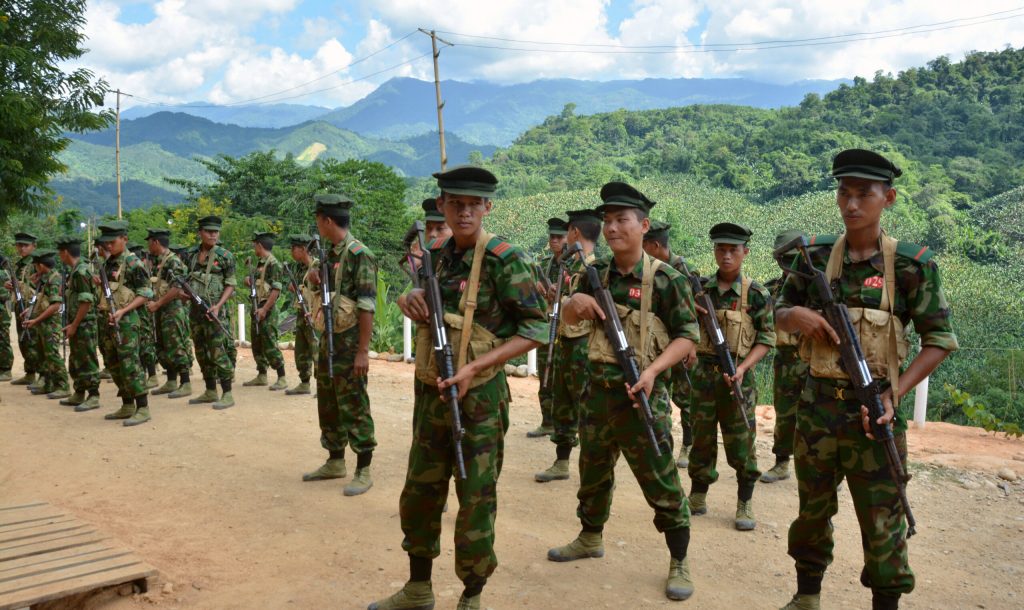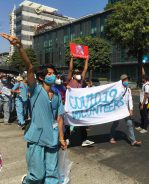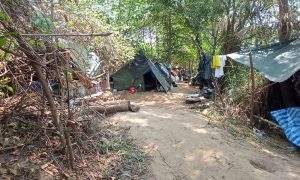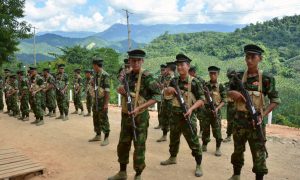Earlier this month, the Institute for Economics and Peace (IEP), a Sydney-based thinktank, published its latest annual report on global terrorism. The Global Terrorism Index claimed that Myanmar saw the largest increase in terrorism-related deaths worldwide, rising from 24 in 2020 to 521 in 2021. The cause? The report’s authors cited “current political unrest” as the source of this violence, and claimed that deaths were sure to rise as the “unrest” continued into 2022.
The Index claimed that anti-junta armed groups were responsible for “over half of terrorism deaths in 2021”. But the examples it offers are of attacks against military personnel, such as an ambush by resistance forces in Sagaing region that killed 40 Tatmadaw troops. Such examples contradict even the IEP’s own definition of terrorism, which excludes “acts of warfare, either irregular or conventional.”
The report makes no mention of state-sponsored violence perpetrated by the Myanmar military, which took control of the country in a coup last year. Since February 2021, the junta-appointed State Administrative Council (SAC) has waged a brutal campaign of terror against civilians protesting the military takeover. As of May 16th, the army has killed 1,835 people and arrested 10,650. In this conflict, terrorism certainly abounds—but it is being carried out by the state itself, not the civilians trying to resist it.
Not terrorism, but war
The IEP’s mischaracterisation of the conflict in Myanmar drew fierce criticism from a community of scholars specialising in Myanmar politics and society. A group of academics published an Open Letter to the Institute, criticising its analytical approach and alerting it to the report’s damaging political consequences. The Letter stresses that the incidences cited in the Index are acts of guerrilla warfare—and therefore legitimate under International Humanitarian Law.
“It’s a civil war between different guerrilla forces and the state army,” explains Dr Brenner, lecturer at the University of Sussex, who wrote the open letter. “The war includes terrorist violence, but these are acts of state terrorism, where security forces deploy indiscriminate violence against civilian populations to punish, intimidate, and ultimately seek to alter the behaviour of their opponents—i.e., the anti-junta resistance.”
What started as a nationwide protest movement has morphed into a fully-fledged armed uprising made up of People’s Defence Forces (PDFs) aligned with a select number of Ethnic Armed Organisations (EAOs). While PDFs and EAOs operate independently on the ground, they are united in their objective to overthrow the military leadership—a goal they share with Myanmar’s leadership in exile, the National Unity Government (NUG). The self-declared parallel government, which was established by former NLD members and other pro-democracy politicians, called for nationwide “defensive war “against military rule in September last year.
“Most of the military action […] conducted by the so-called People’s Defence Forces (PDF) takes place, in its own eyes, as action by and on behalf of the National Unity Government, and is aimed at the defeat of the illegal takeover of government institutions on 1 February 2021,” explains Honorary Associate Professor Christopher Lamb, former Australian ambassador to Myanmar. “I would have expected an Index seeking acceptance as authoritative to have dealt with this sensitively and accurately and definitely not as one comparable with the other terrorism situations described in the Index.”
The nationwide resistance movement encompasses not just violence but also strikes, protests, blockades, and other actions.
“Armed resistance is only one manifestation of wide-spread resistance in Myanmar. This is also why the armed resistance forces in Myanmar do not target civilians amongst whom they enjoy popular support. They directly attack their political opponent: the junta’s state apparatus, and in particular its security forces,” says Dr Brenner. “This is not surprising. After all we are speaking about a state that has committed countless atrocities against its own population for decades, including genocide.”
The Centrality of the Civil Disobedience Movement in Myanmar’s Post-Coup Era
Humanitarian work without the recognition of the CDM will provoke public distrust and rejection.
Fanning the flames
The IEP’s failure to acknowledge the state as the main perpetrator of terrorism in Myanmar is not only analytically flawed—it is inattentive to the politics on the ground.
“It’s an outrageous distortion of reality, which is politically highly problematic because it plays to the very narrative that the junta is using in trying to legitimize its indiscriminate violence against civilians,” explains Dr Brenner.
While the IEP presents its research as data-driven, and therefore politically neutral, reports like the Global Terrorism Index do more than simply measure empirical facts—they construct political realities.
“[The report] is not only an insult to, but also harmful for the people of Myanmar, who are suffering daily—and have suffered for decades—under a terrorist armed criminal cartel that calls itself the country’s military and employs actual terrorist methods to subjugate the whole population into submission in order to enforce their political view and rule on the country,” says Mr Georg Bauer, a PhD candidate at the University of Vienna and one of the first people to approach the IEP over the contents of the report.
“Given the IEP’s reputation, this will inadvertently hurt the Revolution’s and the legitimate government’s chances to get much-needed international support, and embolden the SAC to continue its campaign of terror,” adds Mr Bauer.
Undoing the damage
The IEP redacted the Myanmar section of the report after the open letter was circulated—there is now no mention whatsoever of Myanmar in the Global Terrorism Index. The institute also issued a statement of reply, in which they emphasised their credentials as an “internationally respected not-for-profit organization” and justified their decision not to include acts of state-sponsored violence in the Index. But they failed to attribute the source of the violence to the state security forces. Nor did they respond to one of the Open Letter’s core demands: an apology.
Why did the IEP use this language in the first place? Dr Brenner puts it down to a flaw in their research design, which privileges state actors over non-state ones.
“That the IEP […] depicts resistance forces as the source of terrorist violence can only be explained by a deeply statist ideology, which views internationally recognised states as inherently legitimate and non-state resistance as naturally dubious, despite the fact that states have been and continue to be the source of most violence and atrocities in the modern world,” says Dr Brenner.
On another level, the IEP report shows how damaging quantitative research can be when it is divorced from its context and its history. The IEP use TerrorismTracker, an online database that plots all so-called “terrorist“ incidences that have occurred since 2007 on a map. But such data is meaningless on its own.
“Words are powerful, and “terrorist” is the most damaging label that one could possibly give to political stakeholders in the 21st century. This is even more so when the labelling is done from an allegedly non-partisan international think tank that prides itself for collaborating with UN agencies and counterterrorism agencies. In labelling anti-junta forces as “terrorists”, the IEP made itself complicit in the junta’s propaganda” says Dr Brenner.
 Facebook
Facebook  Twitter
Twitter  Soundcloud
Soundcloud  Youtube
Youtube  Rss
Rss 



